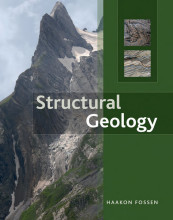Summary: Structural Geology | 9780521516648 | Haakon Fossen
- This + 400k other summaries
- A unique study and practice tool
- Never study anything twice again
- Get the grades you hope for
- 100% sure, 100% understanding
Read the summary and the most important questions on Structural Geology | 9780521516648 | Haakon Fossen
-
1 lecture 1
This is a preview. There are 3 more flashcards available for chapter 1
Show more cards here -
Kinematic criteria to determine the sense and direction of movement in brittle rocks
1 fault drag (sleur) reliable criterion as long as outcrop face is at high angle to the fault and layers and the slip vector is at small angle to the fault.
2 . secondary faults/structures3. slickensides with slickenlines or slickolites (less reliable)
-
4 Stress
-
4.1 Definitions, magnitudes and units
This is a preview. There are 1 more flashcards available for chapter 4.1
Show more cards here -
What is pressure, in geology?
Pressure (p) is limited to media with no (or little) shear resistance, such as fluids. -
What are the two types of forces?
- Body forces: affect entire volume of rock (outside and inside)
-define 3D fields, e.g. gravity or magnetic forces - Surface forces: acts across the contact area between two bodies
-very important during deformation
- Body forces: affect entire volume of rock (outside and inside)
-
4.2 Stress on a surface
This is a preview. There are 3 more flashcards available for chapter 4.2
Show more cards here -
What is shear stress?
A stress vector that acts parallel to surface. -
4.3 Stress at a point
This is a preview. There are 1 more flashcards available for chapter 4.3
Show more cards here -
Stress ellipsoid and its orientation
- Tells us everything about the state of stress at a given point in a rock, or in a rock volume (in which stress is homogenous)
- Has three axes: the principle stresses, are poles to the principle planes of stress:
σ1 is the longest, in the direction of maximum stress
σ3 is the shortest, normal to the plane with the least surface stress (traction)
-
5 lecture faults
This is a preview. There are 10 more flashcards available for chapter 5
Show more cards here -
What is the significance of faults?
• Faults make movements in the earth possible and are hence important for plate tectonics.
• Knowledge of faults is needed to understand maps and sections.
• Faults are important for topography and morphology of the earth’s surface.
• Faults control the permeability of rocks and are of importance for the migration of fluids
• Faults are important for oil and gas fields and ore deposits
-
6 Folds
This is a preview. There are 6 more flashcards available for chapter 6
Show more cards here -
Fold axes (plooias):
straight line that when moved parallel to itself, generates the form of the fold
Axial surface (assenvlak):
to itself, generates the form of the fold
-
Buckling, bending, passive folding
plaatjes -
Active Folding (flexural folding)
• layering has mechanical significance
i.e. layers have different mechanical
properties.
• presence of layers with different
competency affect the strain pattern
• dynamic conditions for active folding
-
8 Fracture and Brittle deformation
-
8.1 Brittle deformation mechanisms
This is a preview. There are 2 more flashcards available for chapter 8.1
Show more cards here -
What is the brittle regime?
where physical conditions promote brittle deformation mechanisms- as frictional sliding along grain contacts,
- grain rotation,
- grain fraction
- Higher grades + faster learning
- Never study anything twice
- 100% sure, 100% understanding
































